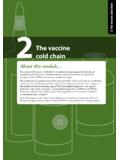Transcription of Immunization Strategies for Healthcare Practices and ...
1 Immunization Strategies for Healthcare Practices and Providers293An important component of a vaccine provider s practice is ensuring vaccines reach all patients who need them, when they need them. Providers should implement systems and programs to provide effective vaccine delivery and to maintain and increase vaccination coverage in their Practices . By creating a culture of Immunization in the practice, both providers and patients can vaccinate with disease rates in the United States are at low levels. In 2018, four cases of rubella, one case of diphtheria, and 23 cases of tetanus were reported to CDC. However, the viruses and bacteria that cause vaccine-preventable diseases and death still exist. Diseases can be passed to unprotected persons or imported from other countries, as shown by the measles outbreaks that occurred in 2019 in New York and other states. Diseases such as measles, mumps, and pertussis can be more severe than often assumed, and can result in social and economic costs in addition to the physical costs: sick children miss school, parents have to take time off from work, and outbreaks can severely disrupt health care systems.
2 Sustainable systems for vaccinating children, adolescents, and adults must be continued in the context of a changing health care environment. High vaccination coverage cannot be maintained with one-time or short-term efforts. Greater understanding of Strategies to increase and sustain vaccination coverage is necessary to create lasting, effective Immunization delivery systems. Many public health Strategies have been used to increase vaccination coverage. Some, such as school entry laws, have been effective in increasing vaccination compliance, but the effectiveness of other Strategies ( , advertising) is not well-documented. Some proven Strategies ( , reducing costs, linking vaccination to Women, Infants, and Children [WIC] services, home visits) work well to increase coverage among specific populations, such as persons with limited access to Immunization services. However, creating a culture of Immunization within a health care practice also plays a critical role in maintaining and increasing vaccination coverage, as well as ensuring vaccines are delivered safely, effectively, and on chapter explores Strategies health care providers can implement within their own Practices .
3 It covers system-level interventions such as quality improvement programs, as well as practice-level actions directed toward patients and provider Bjork, PhD and Valerie Morelli, 202130 Immunization Strategies for Healthcare Practices and Providers 3 Standards for Child, Adolescent, and Adult Immunization PracticesAll health care providers in all settings are encouraged to ensure patients are up-to-date on vaccinations. The National Vaccine Advisory Committee s (NVAC) Standards for Child and Adolescent Immunization Practices and Standards for Adult Immunization Practice are recommended for use by all health care providers in the public and private sectors. The standards represent the most desirable Immunization Practices that providers should strive to achieve, regardless of whether they actually provide vaccinations. Providers implementing these standards will help ensure their patients are fully vaccinated, thereby helping to increase vaccination coverage and prevent outbreaks.
4 The Standards for Child and Adolescent Immunization Practices outline standards within five categories: Availability of vaccines Assessment of Immunization status Effective communication about vaccine benefits and risks Proper storage and administration of vaccines anddocumentation of vaccinations Implementation of Strategies to improvevaccination coverageThe Standards for Adult Immunization Practice include the following four standards: Assess Immunization status of all adult patients at everyclinical encounter Strongly recommend vaccines that patients need Administer vaccine or refer patients to a vaccine provider Document vaccines received by patientsThe Guide to Community Preventive ServicesThe Community Preventive Services Task Force s Guide to Community Preventive Services is a collection of evidence-based findings based on effectiveness data and economic evidence.
5 The vaccination section of the Guide to Community Preventive Services describes strong or sufficient evidence to support several provider-based Immunization Strategies discussed throughout this chapter. NOTESI mmunization Strategies for Healthcare Practices and Providers313 Health Care Practice Quality Improvement Programs Immunization quality improvement projects can be particularly effective because vaccination is a dynamic, critical, and measurable area of health care. It is rapidly evolving, making fast strides in some areas, but lagging in others, such as human papillomavirus (HPV) vaccination. CDC encourages health care providers to consider implementing Immunization quality improvement projects that:1. Generate measurable increases in child, adolescent, and adult vaccination Bring about measurable increases in HPV vaccination coverage, particularly rates of coadministration with other adolescent vaccines at age 11 or 12 Bring about measurable increases in vaccination coverage of pregnant women, specifically for influenza and pertussis.
6 4. Reduce disparities in vaccination coverage, whether associated with race, ethnicity, type of health insurance (including lack of insurance), or any other factor resulting in less than optimal coverage. Immunization Quality Improvement for Providers (IQIP)CDC works with state, local, and territorial public health agencies to administer the Immunization Quality Improvement for Providers (IQIP) program to introduce and sustain new or improved Immunization Practices . Designed to increase on-time vaccination at the provider level, IQIP Strategies are intended to increase vaccine uptake among child and adolescent patients in adherence with the Advisory Committee on Immunization Practices (ACIP) routine Immunization schedule. IQIP is targeted toward quality improvement among providers enrolled in the Vaccines for Children (VFC) program. IQIP OverviewIQIP serves to assist and support providers by identifying opportunities to improve vaccine uptake, determining options for improving Immunization delivery Practices , and ensuring providers are: Aware of and knowledgeable about vaccination coverage within their Practices and missed opportunities to vaccinate Motivated to try new Immunization service delivery Strategies and incorporate changes into their Practices Capable of sustaining changes and improvements to their Immunization delivery servicesNOTES32 Immunization Strategies for Healthcare Practices and Providers 3 The IQIP ProcessIQIP is a 12-month process where public health representatives and VFC providers collaborate to identify Strategies to increase vaccine uptake by improving and enhancing Immunization workflow.
7 The collaborative process includes vaccination coverage measurement at or near the time of an initial site visit and again one year later to evaluate progress. Technical assistance and support occur at two- and six-month intervals to aid providers in staying on course with implementing Strategies to improve vaccine Strategies include: Scheduling the next Immunization visit before the patient leaves the provider site Leveraging Immunization information system (IIS) functionality to improve Immunization practice Giving a strong vaccine recommendation for patients Optional Strategies as defined by the needs of state and local communitiesIQIP has replaced CDC s previous Assessment, Feedback, Incentives, and eXchange (AFIX) quality improvement program to better address the current health care Information Systems (IISs)Many record-keeping tasks, as well as patient reminder and recall processes, can be greatly simplified by participation in an IIS.
8 An IIS is a confidential, population-based, electronic database that records all vaccine doses administered by participating providers to persons residing within a given jurisdiction. In some areas, an IIS links to a complete medical record. While electronic health records (EHRs) include vaccination information, they may not provide a consolidated Immunization history. An IIS provides a single data source for all community vaccination providers, enabling them to access records of persons receiving vaccinations from multiple providers. Data exchange between IISs, EHRs, and other information systems helps ensure timely vaccinations and records consolidation and allows Immunization personnel to work more efficiently. At the point of clinical care, an IIS can provide consolidated Immunization histories for use by a provider in determining appropriate patient vaccinations.
9 At the population level, an IIS provides aggregate data on vaccinations for use in surveillance and program operations and for guiding public health action, with the goals of improving vaccination coverage and reducing rates of vaccine-preventable diseases. NOTESI mmunization Strategies for Healthcare Practices and Providers333 The Guide to Community Preventive Services recommends IISs based on strong evidence that their use increases vaccination coverage. IISs can directly contribute to efforts to increase vaccination coverage through their abilities to: Create or support effective interventions such as patient reminder and recall systems, provider assessment and feedback, and provider reminders. Generate and evaluate public health responses to outbreaks of vaccine-preventable disease. Facilitate vaccine inventory management and accountability. Determine patient Immunization status to inform decisions made by health care providers, clinicians, health departments, and schools.
10 Aid surveillance and investigations of vaccination coverage, missed vaccination opportunities, and invalid dose , state, and local public health agencies are continuing their efforts to improve IISs and to increase participation by vaccine providers. IISs are a key to increasing and maintaining vaccination coverage, and they offer advantages for providers, patients, and state and federal Immunization program staff. essential Strategies for Health Care PracticesIn addition to implementing a quality improvement program such as IQIP and participating in an IIS, other effective practice Strategies exist that complement these programs. These Strategies focus on patient confidence in vaccination and provider development of a culture of Immunization within a StrategiesStrong Vaccination Recommendation A strong recommendation by a health care provider is a powerful motivator for patients to comply with vaccination recommendations.














